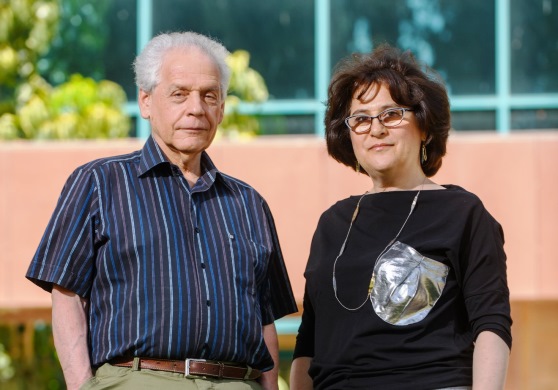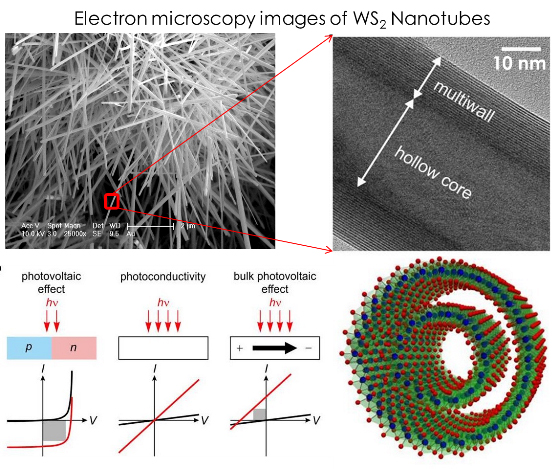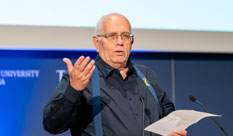More:
News & Stories
Paper by Prof. Alla Zak and collaborators was published in NATURE
"Publication in NATURE magazine, which is considered to be the most prestigious scientific journal, is an indicator of the great significance of the discovery described in this work", says Prof. Zak.
The published findings are the fruits of intensive research done over the years by a group of scientists headed by Prof. A. Zak from HIT, Prof. R. Tenne from the Weizmann Institute of Science, Prof. Y. Iwasa from Japan and Dr. Y. Zhang from Germany.

Prof. Alla Zak, HIT and Prof. Reshef Tenne, Weizmann Institute
The paper reports a unique optoelectronic phenomenon important for the development of renewable energy sources and discovered in a crystal shaped-like tube with a diameter 1000 times smaller than the diameter of a single human hair. The diameter of the tubular crystal is a few tens of nanometer (1nm = 10-9 m). The nanocrystals are named – inorganic nanotubes.
“Due to their tiny size and unique shape, the nanotubes which we synthesize at HIT, reveal the ability to absorb the sun energy and convert it into electrical energy with high efficiency", says Prof. Zak.
The studied nanotubes were made of the compound, named tungsten disulfide (WS2) which belongs to the class of "layered materials" (materials composed of molecular layers like books made up of sheets). This results in flexible crystal structure and allows layers to bend and close into nanotubes made up of many layers. These nanotubes act like semiconductors and showed an impressive mechanical strength.
Inorganic nanotubes as well as inorganic nanoballs (spherical nanocrystals), were initially discovered at the Weitzman Institute in the lab of Prof. Reshef Tenne from the Department of Materials and Interfaces, 27 years ago. "Since that time Prof. Tenne proved that dozens of different materials can produce such tubular and spherical nanostructures. This discovery opened up a new research area in inorganic chemistry and many research groups around the world followed Tenne’s finding in attempt to form multi-layered nanoballs and nanotubes of ‘layered materials”, says Zak
Prof. Alla Zak, nowadays Head of the Laboratory for Synthesis and Investigation of Nanomaterials at HIT, had joined the field more than two decades ago. She was among the founders of a company (NanoMaterials, Ltd.) which manufactured nanoballs from WS2. During her tenure as the Chief Scientist of the company, Prof. Zak built research labs and later - an entire factory for industrial production of these nanostructures. “The idea of how to synthesize the nanotubes was conceived during that time”, says Prof. Zak.
While Prof. Tenne’s pioneering research nearly three decades ago led the way to new understanding of nanoballs and nanotubes structure, he indicates that “it took another 20 years to figure out how to produce them in a pure form, in the desirable size and significant quantities that are required for a broad spectrum of research.”
"Throughout her entire career, one of the main research interests of Prof. Zak was the study of the nanotubes’ growth mechanism. She was the first to offer a method to produce them in a pure form and in generous quantities. And this enabled the first far-reaching research into the various properties of WS2 nanotubes", continues Prof. Tenne.
In recent years, Tenne and Zak have been collaborating with Prof. Yoshihiro Iwasa's group from Tokyo University and the RIKEN institute in Japan, and his former student, Dr. Yijin Zhang, who currently works in Germany at the Max Planck Institute in Stuttgart. These researchers study the physical properties of the nanotubes while trying to find new and innovative behavior of this unique material.
During this research project, the scientists have discovered that WS2 crystal layers, when bent into nano-sized tubes as spirals, possess new crystal habits reducing crystal symmetry, becoming chiral and therefore polar. These changes affected the crystal properties.
The results of the first set of experiments were published about two years ago in NATURE Communication. The research team found out that at low temperatures, the nanotubes become superconductors due to the spiral trajectory the conductive electrons follow in the nanotube, while this trajectory results from nanotube' chiral structure and its nanosize. It should be emphasized that this supercurrent does not exist in regular WS2 crystals, which are of macro-size or in any other material.
The next question considered was whether the semiconductive nanotubes can absorb light and produce electricity? This is a primary action of a solar cell based on regular semiconductors. This means that light absorbed by the material excites free charge carriers - electrons and "holes", which can move establishing an electrical current.
In order to test this idea, the research group used focused laser beams and directed them to the center of a single nanotube. The nanotube edges were connected to a current collector through electrical golden nano-contacts.
“Surprisingly, the WS2 nanotubes exhibited an abnormal photovoltaic effect, named Bulk Photovoltaic Effect (BPVE). The generated current was several orders of magnitude stronger than in any other similar (polar) material.
Usually the electrons that are generated by light absorption are attracted by an electric field which is formed at the contact area between two semiconductors (p-n Junction) or a metal and a semiconductor (Schottky barrier), producing a photocurrent. In our nanotubes the electrical current exists without a p-n Junction or Schottky barrier, but rather was caused by the intrinsic quantum mechanics behavior of the nanotube, provided by the polarity in their chiral structure. This phenomenon relates to a “bulk photovoltaic effect”, says Prof. Zak

Comparison of three different light-to current conversion mechanisms (left); Schematic of a nanotube structure (right).
Prof. Zak and Prof. Tenne intend to continue to investigate the BPVE phenomenon in various directions. They are interested in exploring other types of inorganic nanotubes - to determine whether they produce a similar bulk photovoltaic effect, or perhaps even a stronger one. For instance, Prof. Zak succeeded recently in synthesizing nanotubes from a similar layered material - MoS2 that might show new interesting qualities.
"We are planning to study whether it is possible to increase the nanotubes’ ability to absorb sun rays and increase the photocurrent by inserting deliberate faults ("doping"), which will assist the electrons’ movement", says Prof. Tenne.
The research agenda of Prof. Zak and Prof. Tenne is full of new ideas and directions which they wish to follow in their collaborative scientific efforts.
Posted: 20/06/2019
- News & Events
New Collaboration with Sheba Medical Center will qualify nurses to work in a digital environment.
Collaboration between HIT Holon Institute of Technology, the teaching authority of the Sheba Medical Center, and the Sheba-BEYOND virtual hospital will allow training nurses in Israel and around the world to work in a digital...



 Additional programs
Additional programs
